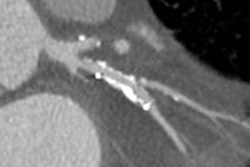Training and experience wield a huge effect on reader accuracy in coronary CT angiography (CCTA) interpretation, and current minimum standards may not be sufficient, concluded a new study published online in the European Journal of Radiology.
In a study of 100 patients and nine readers with varying experience levels, the correlation between CCTA and catheter angiography results was significantly closer for experienced readers, and the results improved again significantly after a second training session, authors from institutions in Europe and the U.S. reported.
"The level of experience appears to be a strong determinant of proficiency in CCTA interpretation," wrote Dr. Christoph Herzog from the Medical University of South Carolina, Johann Wolfgang Goethe-University in Munich, and colleagues from those institutions as well as Bayerwald-klinik in Cham, Germany (EJR, April 16, 2013).
Most doctors have limited exposure to CCTA certification during graduate medical education, and requirements for the demonstration of advanced proficiency differ between countries and medical specialties. What physicians do share is a certificate of proficiency in CCTA interpretation, which requires mentored interpretation of 50 cardiac CT cases. But it is not clear whether this limited training is sufficient, and the issue has not been examined.
"There is a scarcity of evidence regarding the influence of experience and training of practitioners on their proficiency, i.e. their ability to independently render CCTA interpretations of a quality commensurate with the clinical use of this test" to contribute to patient management, Herzog et al wrote.
The study aimed to evaluate the influence of reader experience as well as the effect of one-time limited training on 50 cardiac CT cases on proficiency in readers with different experience levels. The 100 patients all had a low pretest likelihood of disease, but were referred for catheter angiography for chest pain.
The study examined nine radiologist and cardiologist observers with widely divergent experience levels in CCTA interpretation that ranged from novice to expert. They independently analyzed two case series of 50 CCTA studies for coronary artery stenosis (0%, ≤ 49%, 50% to 74%, 75% to 99%, or 100%).
Following administration of 50-75 mL of nonionic contrast at 5 mL/sec and sublingual nitroglycerine, patients were scanned using a 64-detector-row machine (Somatom Sensation 64 Cardiac, Siemens Healthcare) using retrospective gating and 6-mm collimation, 120-kV tube voltage, and 900-mAs tube current. The beta-blocker metropolol was given to patients with heart rates greater than 65 bpm.
CT images were reconstructed using the R-R interval with the least cardiac motion using a section thickness of 0.75 mm and an increment of 0.3 mm.
Three experienced cardiologists performed angiography using the Judkins technique, including at least four views of the left and two views of the right coronary artery, the authors noted.
Results of the first case series were unblinded and presented along with results from conventional angiography to each reader before proceeding to the second series, Herzog et al wrote. The researchers compared diagnostic accuracy for all readers and for both case series.
Initial results showed correlation coefficients between CCTA and angiography ranged between good (r = 0.87) and poor (r = 0.26), depending on reader experience, and significantly (p < 0.05) improved in the second case series (range: r = 0.42 to r = 0.91).
Diagnostic accuracy was significantly higher (p < 0.05) for more experienced readers (range: 96.5% to 97.8%) when compared with less experienced readers (range: 90.7% to 93.6%).
After completing the second case series, sensitivity and PPV significantly (p < 0.05) both rose (range: 62.7% to 67.8%/51.4% to 84.1%) for less experienced readers, but measures remained significantly (p < 0.05) lower than those of more experienced readers (range: 89.8% to 93.3%/80.6% to 93.3%). And after the second case series, significant differences between novice readers were no longer found.
"The results objectify in a systematic manner the intuitive notion that the level of experience is the strongest determinant of proficiency in CCTA interpretation," Herzog et al wrote. "The results also show that limited one-time training improves proficiency -- particularly in less-experienced readers, but not to clinically satisfactory levels."
For reading CCTA results, the standard measure of proficiency across medical specialty and prior qualifications is at least 30 hours of continuing medical education in cardiac imaging along with supervised review of at least 50 exams that includes without limitation cardiac CT. This is considered level I proficiency.
However, proficiency levels aren't based on established metrics for reader improvement, and "thus merely represent consensus-based compromises between what is considered clinically possible and individually achievable," Herzog et al wrote.
Conclusion: The level of experience appears to be a strong determinant of proficiency in CCTA interpretation. Limited one-time training improves proficiency in novice readers, but not to clinically satisfactory levels.
"In our study interpretational competence of readers with > three years of experience and of observers with shorter duration but high frequency of exposure were not significantly different," Herzog et al wrote. "Thus, sufficient proficiency in cardiac CT may be gained by the frequency of exposure rather than the time spent in a certain subspecialization. This may also explain the rapid convergence in diagnostic competency of the five cardiac CT novices after accomplishment of the initial 50 CCTA case series."
Still trainees have different degrees of "aptitude and zeal," and it would be helpful to conduct the study with larger numbers of readers, perhaps a whole class, while opening up the cases to more than a single center, they noted.



















